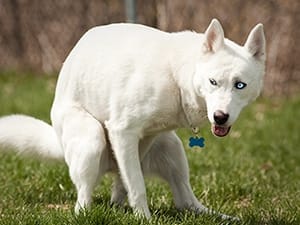Contents
Constipated dog
Constipated dog: what are the symptoms?
A normal dog defecates on average twice a day. A constipated dog will try to defecate unsuccessfully or pass hard, small, and dry faeces. Sometimes pain appears during defecation, this is called tenesmus and the dog “pushes” abnormally. Constipation can also in some cases be accompanied by bleeding. The constipated dog can lose his appetite and even vomit. Her stomach may be a little more swollen than usual.
Causes of constipation in dogs
The causes of constipation can be more or less serious illnesses as they can be completely benign and temporary like stress or an unbalanced ration.
Anything that will obstruct the passage of stool through the rectum, colon, or through the anus can be a cause of constipation in dogs. Thus tumors in the lumen of the digestive tract (the inside of the digestive tract) but also tumors outside, compressing the distal digestive tract can give symptoms of constipated dogs. In the same way, the hyperplasia, increase in size, of the prostate in the uncastrated male dog is very frequently manifested by tenesmus.
Foreign bodies, especially bones, can cause constipation. This is because bones can block the flow of food in the digestive tract. When a dog eats bones in large quantities it can also create bone powder in the faeces making them harder and therefore more difficult to eliminate.
Anything that will slow down the transit can constipate the dog as well. Dehydration by preventing the stool from being properly moistened can delay stool elimination. Likewise, a diet that is too low in fiber can slow down digestive transit. Severe abdominal pain can slow down digestive peristalsis (these are the movements of the intestines) and interfere with its mission, which is to stir and move the digested food bolus to the rectum and anus. Many other metabolic, inflammatory, or nerve causes can slow or suppress digestive motility. It should also not be forgotten that certain drugs such as anti-diarrhea drugs (spasmolytics) as well as morphine and its derivatives can be an iatrogenic cause of stopping digestive transit.
Dog constipation: examinations and treatments
Constipation without tenesmus, without loss of general condition and without other symptoms does not constitute a danger to the health of the dog.
Care must be taken to increase the proportion of fiber in the ration of the constipated dog by offering him vegetables cooked with his usual ration such as green beans or zucchini. If you don’t feel like cooking you can also buy boxes of diet food pies from your vet that contain more fiber than normal foods. Some dogs may have temporary constipation following a big stressful stroke (such as moving or being in a kennel).
If your dog has other symptoms in addition to constipation, if the constipation becomes chronic or if increasing the proportion of vegetables in his ration with vegetables is not enough, it is strongly advised to consult your veterinarian.
The veterinarian will begin with a classic clinical examination. He will complete the examination with a rectal examination to check for the presence of an obstruction or a rectal lesion. He will also do a careful palpation of the stomach in order to feel the stools but also any abdominal pain. To this he will surely add a biochemical assessment to identify the causes of metabolic constipation and an X-ray of the abdomen. He will also be able in many cases to schedule an abdominal ultrasound, in particular in the event of hyperplasia of the prostate with suspicion of abscess or tumor. The ultrasound also checks that digestive motility is still normal, the presence of foreign body inducing intestinal obstruction, tumors or any other disease in the belly that could be the cause of your dog’s constipation.
Depending on the diagnosis, the veterinarian may be required to give laxatives orally or intra-rectally as well as treatments adapted to the disease responsible for constipation. Some constipated dogs will have their ration modified to avoid recurrence and help in the regular elimination of droppings (vegetables and other fibers of plant origin, wet ration, etc.).










